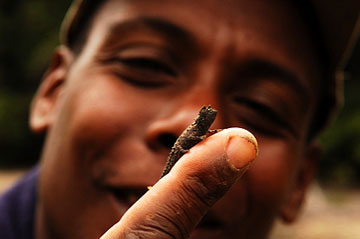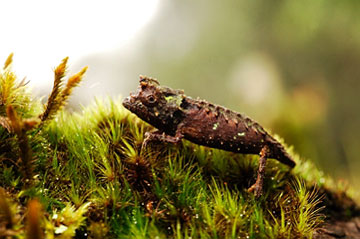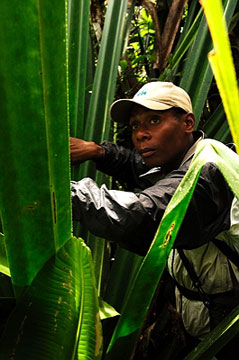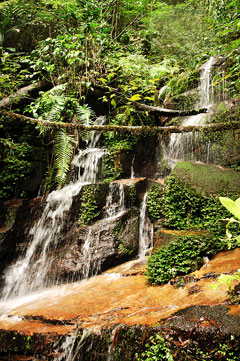Dodging leeches in Madagascar’s unexplored rainforest
Adventures with Julie Larsen Maher, staff photographer of WCS
It is called a rainforest for a reason—because it rains…. and rains. As my field partner, Angelin Razafimanantsoa, and I make our way down muddy mountainsides in the endless downpour, we stop only long enough to pick squirming, bloodthirsty leeches off each other’s face. Hours pass as we wade through knee-deep streams rushing over smooth, slippery rocks and thick forest stands. Seven hours ago, we anticipated arriving at our next base camp in three hours’ time. Now, as night is falling, it seems we have at least five hours more to go.
I am staff photographer for the Wildlife Conservation Society (WCS) based at the Bronx Zoo in New York and on my third photography trip to Madagascar in just over a year. WCS established a conservation program 15 years ago to help protect the wildlife and wild lands of this island country off Africa’s east coast. Poverty, population growth, and unsustainable resource use pose threats to Madagascar’s unique biodiversity, much of which exists nowhere else on Earth. Over 80% of Madagascar’s forests are gone, and preserving those that remain is a global priority. The photos I take here of some of nature’s oddest creatures, the island, culture, and our work in helping to protect them— will be used throughout WCS to educate and inspire those who do not have the opportunity to see this magnificent place firsthand.
  Angelin holding a Brookesia chameleon (top); a Brookesia chameleon on some moss in Makira (bottom). Photos by Julie Larsen Maher, staff photographer of WCS. |
We are hiking in Makira, one of the largest remaining contiguous areas of rainforest in Madagascar. It is believed to harbor some of the broadest biodiversity in the country and perhaps the world. Such lush, unexplored terrain is a photographer’s dream. Much of Makira’s landscape is still unexplored, and trekking through it is also an arduous test of endurance.
While Angelin, a naturalist and herpetologist who has lived his life in the forests of northern Madagascar, moves quickly through the feathery ferns, I have given up trying to walk at all, and I slide down, the steep and muddy incline with only protruding tree roots and tangled vines slowing my rapid descent through the ravine. Thorny branches reach out like giant talons and tear through my clothes. Angelin knows which plant leaves make the best natural bandages. He hands me a soft green one to stop my bleeding wounds.
On my feet again, my eyes are not adjusting as we lose daylight, and I pull my soggy headlamp out of my camera backpack. Gruff sounding grunts rumble from the canopy above us in this primary rainforest.
  Angelin breaking a path through the rainforest of Makira in Madagascar. Photos by Julie Larsen Maher.
|
“Brown lemurs,” whispers Angelin, “they are warning others around the forest that there is something unusual in their midst.”
Another hour, another vertical incline to climb, and we are sludge-sodden as we push past broken bamboo and enormous rotting logs. My sure-footed guide is now walking backward calling to me “put your foot here, hold on here, and DON’T look down.” Even in the most treacherous spots, I am reluctant to part with my camera for fear of missing a great shot.
Suddenly, Angelin disappears, for a moment, as he ducks into the center of a 10-foot-tall Pandanus plant, each of its leaves edged with a thousand tiny daggers. When he steps out, a half dozen red-speckled, green-glowing day geckos race up the leaves. And sitting in his outstretched palm like a tiny jewel is a small frog with bulging eyes. I risk the rain damage to my Nikon D2X digital camera pull it out, wipe off my foggy, mud spattered lens, and shoot.
“Do you want to wait a bit for the rain to stop?” he inquires, then quickly removes his shoe, pulls off his sock, and stuffs a small snake he has just found into the impromtu “le sac”. I take the picture when we catch a drier moment, then he returns the creature to its home.
Throughout our trek, Angelin never stops peering under logs and leaves. He has an exceptional talent for finding “herps”—shorthand for reptiles and amphibians—and is gathering data on the many chameleons, frogs, geckos, and snakes that live amidst the foliage of this unusual and magical place. Some of the species Angelin discovers at a faster rate than I can photograph them may not yet be described or studied by science.
Each morning, I wake to find chameleons, geckos, colorful mantella frogs and more snakes tucked into my hiking boots outside my tent waiting for a photo session. Angelin has an identical twin, Angeluc, who is in the same line of work, but not along on this adventure. I can only image trying to keep up with the forest finds the two of them might produce.
Among the “hottest” herps on this trip are the one-inch chameleons, called Brookesia or stump-tailed, that look like diminutive dinosaurs. Little is known about these fingertip-sized forest dwellers as researching them requires one to spend time in extreme conditions covered in blistering bug bites. Searching for Brookesia in the lower levels of vegetation where they live, and where they may be camouflaged against the side of a trig or laying low in the leaf litter, is literally like looking for a needle in a haystack. I feel fortunate to have photographed nearly a dozen different ones in an array of colors and shapes over a few days time. Some of the photos I am taking may be the only ones in existence! The Brookesia chameleon’s story and my images of them will be some of many used in the new Madagascar exhibit currently under construction at the Bronx Zoo’s historic Lion House (circa 1903). It is scheduled to open in 2007.
I recently received an email from Tim Davenport, a WCS scientist in Tanzania, who discovered a new primate in Africa. He reported that a photo he took with his Nikon digital camera gear was used to introduce what is now known as the highland mangabey to science.
In his letter he wrote, “Recently, the International Commission for Zoological Nomenclature changed its regulations to permit the ‘holotype’ (the individual animal that sets the standard in perpetuity for a new species) to be a photograph, rather than (as in the past) a specimen. My picture is the first photographic holotype of a monkey in Africa and maybe also in the world………”
This thought never left my mind as I continued on in the rain and mud in northeast Madagascar. Maybe a photograph I take will have the same significance!
On the web